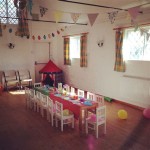Elevating Interior Design: Decorating Ideas with Floating Shelves
Floating shelves, characterized by their seemingly unsupported appearance, have become increasingly popular in contemporary interior design. Their minimalist aesthetic and functional versatility make them a desirable choice for homeowners seeking to maximize space while adding visual interest to their living areas. Unlike traditional shelving units, floating shelves offer a clean, uncluttered look, seamlessly integrating into various design styles from modern to rustic.
The absence of visible brackets or supports contributes to the illusion of items floating against the wall, creating a sense of openness and airiness in a room. This feature is particularly beneficial in smaller spaces where bulky furniture can overwhelm the area. The adaptability of floating shelves allows for creative arrangements and personalized displays, enabling homeowners to showcase their personality and style.
Their application extends beyond mere storage; floating shelves can be strategically used to create focal points, divide spaces, or accentuate architectural features. The choice of materials, colors, and shelf depths further enhances their decorative potential, allowing them to blend seamlessly with the existing decor or stand out as a statement piece. Before delving into specific decorating ideas, it is crucial to consider the structural integrity of the wall and the weight capacity of the shelves to ensure safety and longevity.
Leveraging Floating Shelves in Different Rooms
The versatility of floating shelves allows for their integration into virtually any room in the house. Each room presents unique opportunities for utilizing these shelves to enhance both functionality and aesthetics. The following sections explore specific applications in living rooms, bedrooms, kitchens, and bathrooms.
In the living room, floating shelves can serve as a stylish alternative to traditional entertainment centers. A series of shelves above or beside the television can house media players, gaming consoles, and decorative items such as picture frames, vases, and sculptures. Arranging items in a visually balanced manner, considering height, color, and texture, is essential for creating an appealing display. Books can also be incorporated, adding a literary touch to the space. Furthermore, floating shelves can be used to create a gallery wall, displaying artwork and photographs in a curated arrangement. The absence of bulky frames allows the focus to remain on the art itself.
For bedrooms, floating shelves provide a practical and aesthetically pleasing storage solution. They can be mounted above the bed to serve as a nightstand alternative, holding bedside essentials such as lamps, books, and alarm clocks. This is particularly useful in smaller bedrooms where space is limited. Floating shelves can also be used to display decorative items, adding personality and warmth to the room. In children's bedrooms, they can be used to organize toys, books, and artwork, promoting a tidy and stimulating environment. When installing shelves in a child's room, it is important to ensure they are securely mounted and placed at a safe height.
Kitchens often require innovative storage solutions to maximize space. Floating shelves can be installed to hold frequently used items such as spices, cooking oils, and utensils. Open shelving allows for easy access and visual appeal, showcasing colorful cookware or decorative jars. In smaller kitchens, floating shelves can supplement or replace upper cabinets, creating a more open and airy feel. When selecting shelves for the kitchen, it is important to choose materials that are durable and easy to clean, such as stainless steel or sealed wood. The arrangement of items on the shelves should be both functional and aesthetically pleasing, considering the color and shape of the items displayed.
Bathrooms can also benefit from the addition of floating shelves, providing storage for toiletries, towels, and decorative items. A small shelf above the toilet can hold spare toilet paper and air fresheners, while shelves near the sink can store hand towels, soap, and skincare products. In bathrooms with limited counter space, floating shelves offer a valuable surface for displaying decorative items such as candles, plants, and artwork. Materials used in the bathroom should be water-resistant and durable, such as glass, metal, or sealed wood. Proper ventilation is also crucial to prevent moisture damage to the shelves and surrounding walls.
Material Selection and Installation Considerations
Choosing the right materials for floating shelves is crucial, impacting both the aesthetic appeal and the structural integrity of the installation. The material should complement the existing decor while also being strong enough to support the intended weight. Common materials include wood, metal, glass, and acrylic, each offering unique characteristics and advantages.
Wood is a popular choice due to its versatility and natural warmth. It can be stained, painted, or left unfinished to suit a variety of design styles. Solid wood is generally more durable and can support heavier loads compared to engineered wood products such as MDF or particleboard. However, solid wood can be more expensive and may require more maintenance. When using wood in moisture-prone areas like kitchens and bathrooms, it is important to seal it properly to prevent water damage.
Metal shelves offer a sleek and modern aesthetic. They are typically made from steel or aluminum and can be finished in a variety of colors and textures. Metal shelves are strong and durable, making them suitable for heavy items. They are also easy to clean and maintain. However, metal shelves can be more expensive than wood shelves and may not be suitable for all design styles.
Glass shelves offer a minimalist and elegant look. They are typically made from tempered glass, which is stronger and more resistant to breakage than regular glass. Glass shelves are easy to clean and allow light to pass through, making them a good choice for smaller spaces. However, glass shelves can be more fragile than wood or metal shelves and may not be suitable for heavy items.
Acrylic shelves offer a similar look to glass but are more durable and lightweight. They are available in a variety of colors and finishes and can be easily customized to fit specific design needs. Acrylic shelves are also easy to clean and maintain. However, they can be more expensive than glass shelves and may scratch more easily.
Proper installation is essential for ensuring the safety and stability of floating shelves. The installation process typically involves attaching brackets or supports to the wall and then sliding the shelf over the supports. It is important to use the appropriate hardware for the wall type and the weight of the items that will be placed on the shelf. Stud finders can be used to locate wall studs, providing a secure anchor for the brackets. When installing shelves on drywall, it is important to use wall anchors that are specifically designed for drywall. The weight capacity of the shelves should be carefully considered before installation, as exceeding the maximum weight limit can lead to shelf failure.
Styling and Arrangement Techniques for Floating Shelves
The art of styling floating shelves involves creating a visually appealing and balanced display that reflects personal style and complements the room's overall aesthetic. Achieving this requires careful consideration of color, texture, height, and spacing. The goal is to create a cohesive and visually harmonious arrangement that adds depth and interest to the space.
One important principle of styling floating shelves is the rule of thirds. This involves dividing the shelf into thirds both horizontally and vertically, and then arranging items in a way that emphasizes these divisions. For example, a tall item can be placed in one of the vertical thirds, while smaller items can be grouped together in another third. This creates a sense of visual balance and prevents the shelf from feeling cluttered or overwhelming.
Varying the height of items is another key element of successful shelf styling. Placing items of different heights next to each other creates visual interest and prevents the display from feeling flat. Tall items such as vases or candlesticks can be paired with shorter items such as books or small sculptures. This creates a dynamic and engaging display that draws the eye.
Using a variety of textures can also add depth and interest to the shelf. Combining smooth and rough textures, such as a ceramic vase and a woven basket, creates a tactile and visually appealing display. Natural elements such as plants, stones, and shells can also be incorporated to add texture and warmth to the shelf.
Color is another important consideration when styling floating shelves. Choosing a color palette that complements the room's overall decor can create a cohesive and harmonious look. Neutral colors such as white, gray, and beige can be used as a backdrop, while pops of color can be added through artwork, plants, and decorative objects. It is important to avoid using too many colors, as this can make the shelf feel cluttered and overwhelming.
Spacing is also crucial when styling floating shelves. Leaving some empty space around the items on the shelf allows them to breathe and prevents the display from feeling crowded. Overcrowding the shelf can make it feel cluttered and unorganized. It is better to have fewer items that are carefully curated and arranged, rather than a large number of items that are haphazardly placed.
Functional items can also be incorporated into the shelf styling. Books, storage boxes, and organizational baskets can be both functional and aesthetically pleasing. Choose items that complement the overall design style and color palette of the room. These items can be used to store small items such as keys, wallets, and remote controls, keeping the shelf organized and clutter-free.
Ultimately, the best way to style floating shelves is to experiment and find what works best for personal style and preferences. Try different arrangements, colors, and textures until a visually appealing and balanced display is achieved. Continuously refining the display is key to maintaining a fresh and engaging look. The flexibility of floating shelves allows for dynamic changes based on seasons, trends, or personal preferences.

Ideas For Floating Shelves Shelf Styles

How To Style Shelves In 7 Simple Steps And My Fall Shelf Decor Abby Organizes

Ideas For Floating Shelves Shelf Styles

Thrifty And Chic Diy Projects Home Decor

Modern Floating Shelf Ideas How To Style Wall Shelves

10 Floating Shelf Decorating Ideas For Every Room Drew Jonathan

Modern Floating Shelf Ideas How To Style Wall Shelves

21 Floating Shelves Decorating Ideas Adorable Wall Decoholic Living Room Decor

Crafty Sisters October 2010 Wall Shelves Living Room Decor Bedroom Floating

Design Ideas For Wall Mounted Floating Shelves
Related Posts







